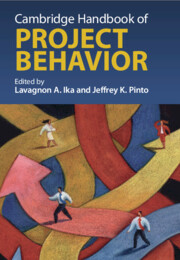Book contents
- Cambridge Handbook of Project Behavior
- Cambridge Handbook of Project Behavior
- Copyright page
- Contents
- Figures
- Tables
- Contributors
- Introduction
- Part I Guiding Principles
- Part II Deviating from Plans
- Part III Practical Tips
- Chapter 13 Setting Realistic Project Goals
- Chapter 14 At the Brink of a Project
- Chapter 15 The Roles of Governance Mechanisms to Manage Misbehaviors in the Project Front-End
- Chapter 16 Coping with Changes to the Plan
- Chapter 17 Project Behavior, Disruptions, and the Antifragility Spectrum
- Chapter 18 Curbing Cost Increases and Benefit Shortfalls
- Afterword
- Index
- References
Chapter 16 - Coping with Changes to the Plan
Dealing with Twists and Turns in Projects
from Part III - Practical Tips
Published online by Cambridge University Press: aN Invalid Date NaN
- Cambridge Handbook of Project Behavior
- Cambridge Handbook of Project Behavior
- Copyright page
- Contents
- Figures
- Tables
- Contributors
- Introduction
- Part I Guiding Principles
- Part II Deviating from Plans
- Part III Practical Tips
- Chapter 13 Setting Realistic Project Goals
- Chapter 14 At the Brink of a Project
- Chapter 15 The Roles of Governance Mechanisms to Manage Misbehaviors in the Project Front-End
- Chapter 16 Coping with Changes to the Plan
- Chapter 17 Project Behavior, Disruptions, and the Antifragility Spectrum
- Chapter 18 Curbing Cost Increases and Benefit Shortfalls
- Afterword
- Index
- References
Summary
To investigate project behaviour, and to better understand it from the perspective of a practitioner, I undertake an ethnographic study of the construction of a house in India that I was recently involved with. I find that the project evolved through three distinct phases – the teething troubles phase, the honeymoon phase and the nightmare phase – each of which displayed distinct behaviours. Using both quantitative and qualitative analysis of observational data, this chapter attempts to describe the evolution of the project through these phases and their inherent internal dynamics. In doing so I provide a micro-perspective on project behaviour, suggestions on how each of these distinct phases can be managed and insights to scholars of project behaviour on how project behaviours is not only fragmented across a project’s lifecycle, but is also perhaps shaped by simultaneously occurring and entangled ‘hands’ or guiding forces. This chapter adds to the debate on whether observed project behaviour that often leads to mis-performance is the result of unwitting or malignant influences.
Information
- Type
- Chapter
- Information
- Cambridge Handbook of Project Behavior , pp. 246 - 264Publisher: Cambridge University PressPrint publication year: 2025
References
Accessibility standard: WCAG 2.0 A
Why this information is here
This section outlines the accessibility features of this content - including support for screen readers, full keyboard navigation and high-contrast display options. This may not be relevant for you.Accessibility Information
Content Navigation
Allows you to navigate directly to chapters, sections, or non‐text items through a linked table of contents, reducing the need for extensive scrolling.
Provides an interactive index, letting you go straight to where a term or subject appears in the text without manual searching.
Reading Order & Textual Equivalents
You will encounter all content (including footnotes, captions, etc.) in a clear, sequential flow, making it easier to follow with assistive tools like screen readers.
You get concise descriptions (for images, charts, or media clips), ensuring you do not miss crucial information when visual or audio elements are not accessible.
You get more than just short alt text: you have comprehensive text equivalents, transcripts, captions, or audio descriptions for substantial non‐text content, which is especially helpful for complex visuals or multimedia.
You can access graphs or charts in a text or tabular format, so you are not excluded if you cannot process visual displays.
Visual Accessibility
You will still understand key ideas or prompts without relying solely on colour, which is especially helpful if you have colour vision deficiencies.
You benefit from high‐contrast text, which improves legibility if you have low vision or if you are reading in less‐than‐ideal lighting conditions.
